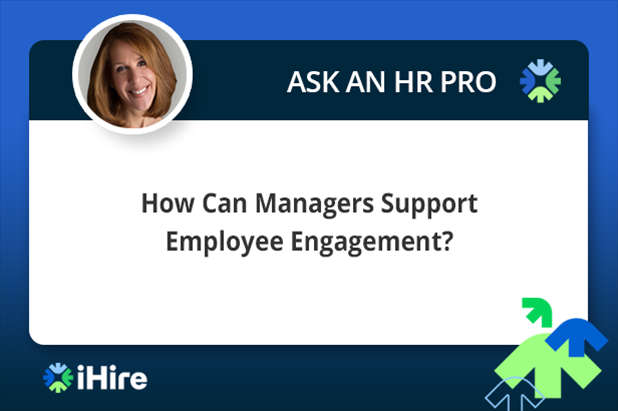- Employer Resources
- |
- Last Updated: April 27, 2023

Ask an HR Pro: How Can Managers Support Employee Engagement?
It’s no secret that high employee engagement correlates with better retention as well as more productive and creative employees. And while many aspects of a workplace can affect an employee’s engagement, few have as much of an impact as their manager. A positive or negative relationship with their manager can make or break how an employee feels about the organization as a whole.
In this Ask an HR Pro, we asked Lisa Shuster, iHire’s Chief People Officer, how managers can support employee engagement and what they should do to keep it high.
How Can Managers Support Employee Engagement?
“Because managers interact with their employees on a regular basis, they are able to impact almost all of the drivers of employee engagement,” Shuster said. “To increase employee engagement and motivation, managers should focus on providing four main things: trust, feedback, alignment, and development.”
Let’s dive into those more.
1. Trust
A common reason for low engagement is a lack of trust in company leadership – and trust diminishes the farther down the chain you look. But Shuster said managers can build trust over time with several actions.
“Managers should work on building their relationships with their employees. Getting to know them – their hopes, desires, career aspirations, families, and personal lives – goes a long way toward building trust.”
Transparency is another way to build a trusting work environment. Shuster recommended sharing as much information as possible (good and bad) during meetings or one-on-one conversations between managers and employees.
“Nothing should be off the table, including staffing plans, product plans, or any information that aids employees in understanding where the company is going. This even includes financials if relevant.”
Create Your Account Today
2. Feedback
Feedback and employee engagement go hand-in-hand. However, while this is a key driver of engagement, most leaders and managers hardly provide any feedback. This can actually hurt your engagement efforts.
“The absence of any feedback is worse than receiving negative feedback,” Shuster clarified. “Frequent one-on-one meetings should be held between managers and employees, where coaching and feedback can regularly occur.”
Some companies are forgoing the annual performance review and replacing it with regular feedback sessions to foster better communication/engagement and employee performance. Shuster is in favor of this idea.
“It’s common knowledge that the annual performance review is rarely effective,” Shuster explained. “It’s not shown to improve performance. Performance reviews are backward-looking as opposed to developmental, and often feel punitive to employees.”
3. Alignment With Company Goals
If an employee doesn’t understand what is expected of them or see how their work contributes to the company’s success, they’re going to be less engaged than they could be. Shuster recommended setting expectations and goals for the employee, and explaining the “why” behind those objectives so they know what they’re doing is important.
“Clarifying job expectations helps to build a bridge of communication and understanding between the employee, the manager, and the strategy of the organization,” Shuster said. “Objective setting can help provide a line of sight between employee performance and company performance.”
4. Development
Growth is a key motivator for most employees, and if you don’t focus on developing your employees, they may stagnate in place – or seek an employer that will. Thankfully, there are many ways that you can accomplish this.
“Start with a willingness to provide any training necessary to help your employee go above and beyond in their existing role,,” Shuster advised. “Then, put a development plan in place, give stretch assignments, and regularly communicate progress with the employee. Most managers miss that last step.”
Remember, feedback and employee engagement are intertwined, and not getting feedback on their growth can put a damper and any initial excitement.
There are many things that managers can do to support employee engagement. By ensuring an atmosphere of trust, providing feedback, giving employees a sense of purpose, and showing how they can grow, managers can help to create a workforce that is motivated, productive, and committed to the success of the organization.
Want more engagement tips for managers? iHire’s HR experts are hosting a live, interactive training session for leaders looking to increase employee engagement and grow their business. In addition to what Shuster discussed above, you’ll learn the benefits and drivers of employee engagement, ways to apply proven motivation and leadership theories, and more. Seats are extremely limited, so register today to secure yours.

Originally Published: April 27, 2023




